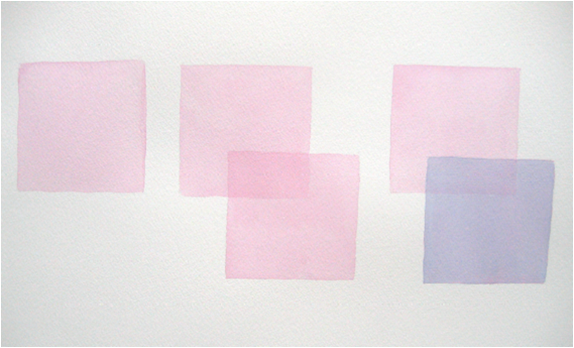Water is integral to watercolors: this is what gives pigments their lightness and luminosity. Mastering water dilution and its effects on colors is one of the major difficulties in watercolors.
- Home
- Expert advice
- Watercolor: colors and water dilution
1. Color values: a matter of intensity
Value is the level of light intensity of a color. With watercolors, all you need to do to vary a hue from dark to light is add water. The more you dilute a color, the more transparent it becomes, allowing the white paper "lightening" it to show through.
Practical advice: Creating your color chart
By creating your own color chart, you can check the actual paint shade, depending on its dilution level.
- Pick up a small amount of paint with your paintbrush and spread it on the Palette.
- Add a little water to your palette, then paint a square of color on a sheet of paper.
- Paint several more color squares the same way, adding a little more water to your palette each time. This will produce a color chart ranging from the darkest to lightest shades.
- Do the same for each of your palette colors.

2. Overlaying colors: Playing for transparency
Due to the transparency of watercolors, it is not possible to cover one shade with another. By overlaying colors, you can systematically obtain a new mix. Three pointers:
- To save on paint, add the darkest color to the lightest: it takes a lot more light paint to change a dark color!
- Quickly apply the second color on top of the first. Do not paint over it again.
- Note that overlaying a third color to the mix, even if it is lighter, will just darken it.
Getting it right
Remember to keep your sheet of paper slightly tilted while working. This will keep the paint from spreading unevenly on the paper or spotting it where the liquid accumulates.

3. White and white spaces
There is no white in watercolors! White paper, the medium generally used, replaces the color white used in other techniques. To paint white, simply don't add paint to the particular surfaces: this is what is called white spaces.
There are two tools you can use:
- Drawing gum: this liquid can very effectively isolate a form; it is applied with a brush, forming a thin protective film, and is readily removed by rubbing once it is dry.
- Chinese white: an opaque white paint, it is used when the white space technique proves delicate (i.e.: a snowy landscape, a field of daisies, the sun sparkling on water).
Recommended product:
XL® Watercolour
See also :
Watercolour
Selecting your watercolor paper
Explore more tutorials on this technique
Watercolour
How to enrich a travel sketchbook
Watercolour
Painting a duck in flight with watercolours
Watercolour
Watercolour pencils: how do I use them properly?
Watercolour
How do I use watercolour ink?
Watercolour
How to paint a seaside landscape in watercolour?
Watercolour
Making Watercolor Paint, Oil Paint, and Gouache
Watercolour
The travel album
Watercolour
Color Basics
Watercolour
Paint and Draw Outdoors
Watercolour
Drawing: Secrets of perspective
Watercolour
Watercolor: Making colors lighter
Watercolour
Watercolor: Splattering
Watercolour
Watercolor: Creating bleeding
Watercolour
Watercolor: Dry brush painting
Watercolour
Watercolor: Trying out different textures
Watercolour
Watercolor: Leaving white spaces
Watercolour
Watercolor: Doing a graduated wash
Watercolour
Watercolor: Salvaging your mistakes
Watercolour
Using watercolor pencils
Watercolour
Watercolor: Doing a flat wash
Watercolour
Watercolor: Seascape under stormy sky
Watercolour
Watercolor: Painting trees
Watercolour
Manufacturing secrets: Watercolor paper
Watercolour
Preparing your watercolor materials
Watercolour
Choosing your watercolor paintbrushes
Watercolour
Selecting your watercolor paper
Watercolour
Watercolor: Choosing your colors
Watercolour
Watercolor blocks
Watercolour
Basic concepts for painting with watercolors
Watercolour
Learn watercolors in 6 steps
